Leica IIIf

|
| Leica IIIf image by Mikel Parial (Image rights) |
The Leica IIIf was Leitz's (later Leica) first 35mm camera body for screw mount lenses (M39) with built-in flash synchronization. Introduced in 1950, it succeeded the Leica IIId, which was a rare variant of the Leica IIIc. Unlike its predecessors, the IIIf didn't need an optional modification (factory or third party) for flash photography. Built-in flash synchronization was an advancement introduced to make flash photography practical, consideting that at the time there were several types of flash bulbs and each had a different guide number and firing delays which made the use of flash difficult. In the Leica IIIf a mechanism was built in the camera with a dial under the speed selecting knob with numbers from 0-20 (the delay time in milliseconds) that simplified the use of all types of flash bulbs. While for today's standards, the need for an extra adjustment in the shape of a contact number between 0 and 20 which depended on the type of flash bulbs used seems complex for the time it was hailed as something that had been long awaited [1]. .
The camera uses any lens in the Leica Screw Mount, and has a coupled rangefinder and a viewfinder without framelines designed for use with a 50mm lens.
The Leica IIIf cameras are known as either Black Dial (early version) or Red Dial (later version) depending on the color of the engraved numbers on the synchronization dial. The original IIIf had black numbers and was made in 1950-1952. Beginning with S/N 615,001 (end of 1952) an upgraded version was made with an improved shutter and flash sync mechanism, shutter is lighter and reduces vibration while increasing the flash sync speed, to mark the change the numbers in the flash sync were changed to red to indicate the new version. On the Red Dial version, the camera included better, more reliable shutter and had an faster flash sync speed of 1/50 of a second vs 1/30 of a second on the Black Dial versions, the changes in flash sync are noticeable in the tables available for the different types of flash bulbs and shutters speeds. It was further upgraded with the addition of a self-timer in 1954, self timer could also be retrofitted in most IIIfs as factory or third party modification.
Serial number range: BD 525,001 - 611,000 (~70,000 units). RD 615,001 - 685,000 (53,000 units). RD-SelfTimer 685,001 - 825,000 (53,733 units). A total of 5,367 cameras were assembled in Ontario, Canada between 1952 and 1956.[2] A special lot of ~100 cameras was made for the Swedish army, painted all black with the 3 crowns engraved in the back and black Elmar 50mm/2.8, these cameras were specially made with special bearings and lubricants to make them resitant to the cold.
Stanley Kubrick took a famous self portrait in a mirror using this camera while working as a staff photographer for LOOK Magazine. The photo is now part of the LOOK Magazine Photograph Collection residing in the US Library of Congress.[3]
Specifications

|
| 1953 IIIf Red Dial with CEYOO flashgun image by Geoff Harrisson (Image rights) |
- Badging: Leica
- Manufacturer: Leitz
- Lens mount: M39 Leica thread mount
- Shutter: cloth focal plane shutter
- Shutter Speeds: 1/1000 to 1 sec, Bulb
- Flash sync: 1/30 (Black Dial) or 1/50 (Red Dial)
- For electronic flash the cameras are different, BD set sync to 2 for 1/30s and RD set sync to 20 for 1/50s or 0 for 1/25[4]
- Focusing: Rangefinder magnified and coupled to lens in separate window than viewfinder for composing
- ISO: 12 - 3200 (depends on the film)
- Meter: none
- Battery: none
- Weight: 430 g (15.2 oz)

|
| Stanley Kubrick with Leica IIIf image by Stanley Kubrick (Image rights) |
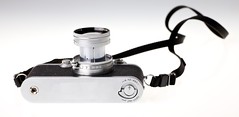
|
| Leica IIIf image by Valerie Ardini (Image rights) |
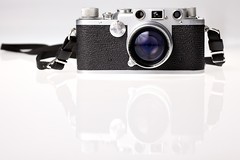
|
| Leica IIIf image by Valerie Ardini (Image rights) |
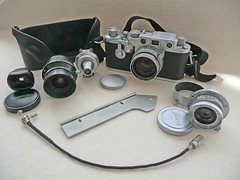
|
| Leica IIIf with accessories image by polbar (Image rights) |
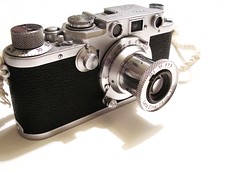
|
| Leica IIIf image by Eden Politte (Image rights) |
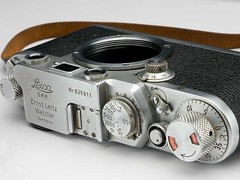
|
| Leica IIIf, top image by Peter M Lerman (Image rights) |

|
| Leica IIIf with 3.5cm Elmar VIOOH finder and high-top case image by Geoff Harrisson (Image rights) |
Notes
- ↑ Leica Fotografie Magazine, 1950, Issue 6. pp 248-253
- ↑ P-H van Hasbroeck, The Leica, (Sotheby 1983; ISBN 0-85667-171-1) Page 99.
- ↑ Wikimedia Commons, Self-portrait of Stanley Kubrick with a Leica IIIf camera (archived)
- ↑ Morgan WD, Lester HM. 1955. Leica Manual and Data Book. Morgan and Lester publishers. 13th ed. page 167
Links
In English:
- Leica IIIf Owner Manual at Mike Butkus' Orphan Cameras
- Leica IIIf article at the Leica Classic Blog
- Leica III f at Ken Lyndrup's Collection of Photo-curios (archived)
- Opening a Screwmount Leica (IIIc or IIIf) for service at Rick Oleson's site.
- Leica IIIf Repair Manual (PDF), at Pentax Manuals
- Servicing Screw Mount Leicas (PDF), also at Pentax Manuals
- Leica IIIf RDST (Red Dial, Self-Timer) by Luis Triguez
- Leica iiif video presentation by YouTuber Kay's Cameras
In French:
- Leica IIIf at summilux.net
- Leica IIIf RDST at Collection Appareils by Sylvain Halgand
In German:
- Leica IIIf story at Peter Lausch's site (archived)